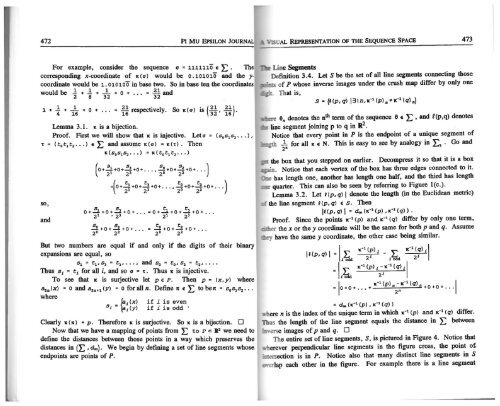Vol. 10 No 6 - Pi Mu Epsilon
Vol. 10 No 6 - Pi Mu Epsilon
Vol. 10 No 6 - Pi Mu Epsilon
- No tags were found...
Create successful ePaper yourself
Turn your PDF publications into a flip-book with our unique Google optimized e-Paper software.
472 PI MU EPSILON JOURNAL<br />
UAL REPRESENTATION OF THE SEQUENCE SPACE 473<br />
The<br />
corresponding x-coordinate of x (a) would be o .<strong>10</strong>1oio and the y<br />
coordinate would be 1. o 1 o 1 o o in base two. So in base ten the coordinates<br />
would be ..! + ..! + _!_ + o + = 21 and<br />
1 +<br />
For example, consider the sequence o = 11111io E :E.<br />
2 8 32 ••• 32<br />
1 1<br />
+ + o + = 2 1<br />
respectively. So x(a)<br />
4 is(~ E-)<br />
16 ° 0 0 16<br />
32 I 16 •<br />
Lemma 3.1. x is a bijection.<br />
Proof. First we will show that x is injective. Let a ( s 0 s 1 s 2 • •• ) 1<br />
T = ( t 0 t 1 t 2 ••• ) E :E and assume x (a) = x ( T) • Then<br />
so,<br />
and<br />
x(s 0<br />
s 1<br />
s 2<br />
•• • ) = x(t 0<br />
t 1<br />
t 2<br />
•• • )<br />
o + s 1 + o + s 1 + o + ••• = o + ..5:. + o + 2 + o +<br />
2 1 '2 1 2 1 2 1<br />
So + 0 + s 2 + 0 + = 2 + 0 + ~ + 0 +<br />
20 22 • . • 20 22<br />
But two numbers are equal if and only if the digits of their binary<br />
expansions are equal, so<br />
s 1 = t 11 s 1 = t 1 I ••• I and s 0 = t 0 I s 2 = t: 2 I ••••<br />
Thus s 1 = t 1 for all i, and so o = T. Thus x is injective.<br />
To see that tt is surjective let p E P. Then p = where<br />
a 2 n (x) = 0 and a 2 a+ 1 (y) = 0 for all n. Define 1t E :E to be1t = s 0 s 1 s 2 • ••<br />
where<br />
if i is even<br />
if i is odd ·<br />
Clearly x ( 1t) = p. Therefore x is surjective. So K is a bijection. D<br />
<strong>No</strong>w that we have a mapping of points from I: to P c: ll 2 we need to<br />
define the distances between those points in a way which preserves the<br />
distances in (E I d..,). We begin by defining a set of line segments whose<br />
endpoints are points of P.<br />
Line Segments<br />
Definition 3.4. LetS be the set of all line segments connecting those<br />
of P whose inverse images under the crush map differ by only one<br />
That is,<br />
6n denotes the nth term of the sequence 6 E L, and £(p,q} denotes<br />
line segment joining p to q in R 2 .<br />
<strong>No</strong>tice that every point in P is the endpoint of a unique segment of<br />
_!. for all x E N. This is easy to see by analogy in L . Go and<br />
2K<br />
the box that you stepped on earlier. Decompress it so that it is a box<br />
· . <strong>No</strong>tice that each vertex of the box bas three edges connected to it.<br />
has length one, another bas length one half, and the third bas length<br />
quarter. This can also be seen by referring to Figure l(c.).<br />
Lemma 3.2. Let 1 (pi q) 1 denote the length (in the Euclidean metric)<br />
the line segment l(p I q) E s. Then<br />
IHPI q) I = d.., cx- 1 (p) I x- 1 (q)) .<br />
Proof. Since the points x- 1 (p) and tt- 1 (q) differ by only one tenn,<br />
the x or the y coordinate will be the same for both p and q. Assume<br />
have the same y coordinate, the other case being similar.<br />
IHP~ q) I = ~1~ x-1~~) 1 - 1~ K-1 ~~) 11<br />
= I<br />
I<br />
j~ IC-1 (p) 1<br />
;j IC-1 ( q) 11<br />
x·l(p)n-x-l(q)n<br />
= 0 + 0 + •• , +<br />
2 n + 0 + 0 + •••<br />
= doo cx·l (p) 1 x•l ( q) )<br />
ere n is the index of the unique term in which tt- 1 (p) and K- 1 (q) differ.<br />
Thus the length of the line segment equals the distance in :E between<br />
• erse images of p and q. 0<br />
The entire set of line segments, S, is pictured in Figure 4. <strong>No</strong>tice that<br />
erever perpendicular line segments in the figure cross, the point o£<br />
rsection is in P. <strong>No</strong>tice also that many distinct line segments in S<br />
overlap each other in the figure. For example there is a line segment<br />
I
















